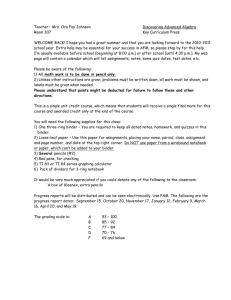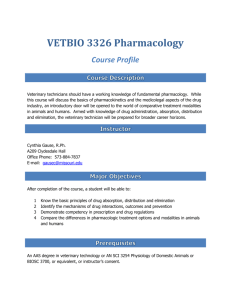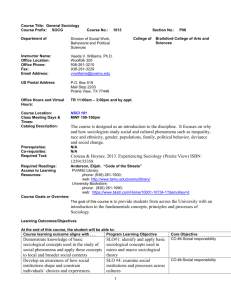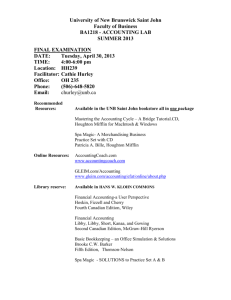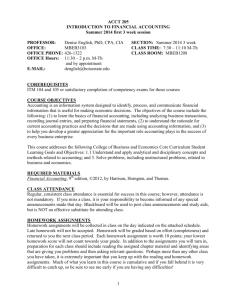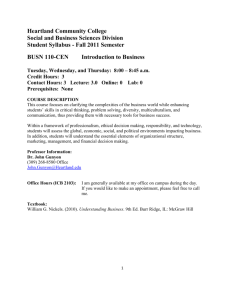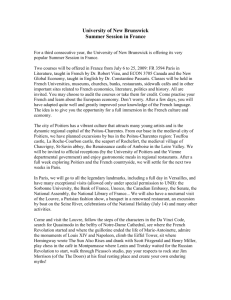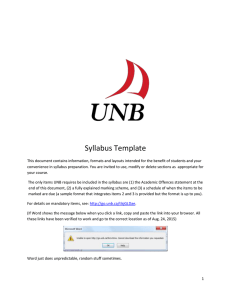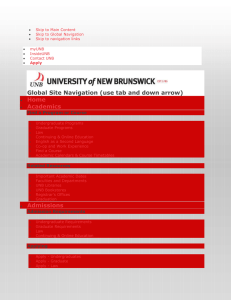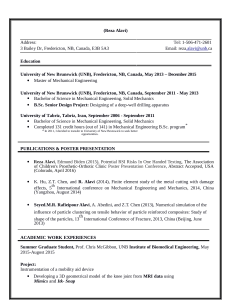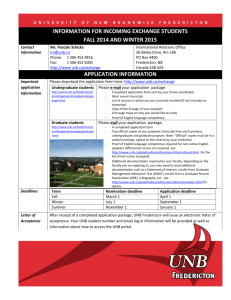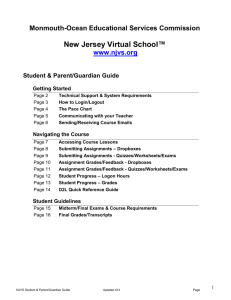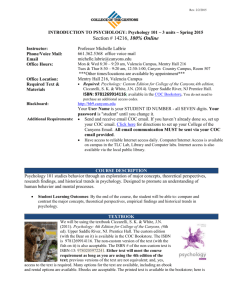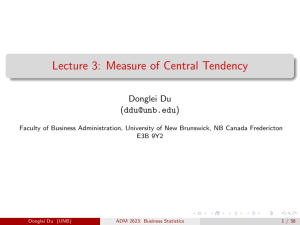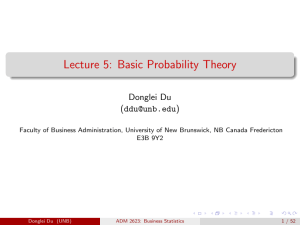01A - University of New Brunswick
advertisement
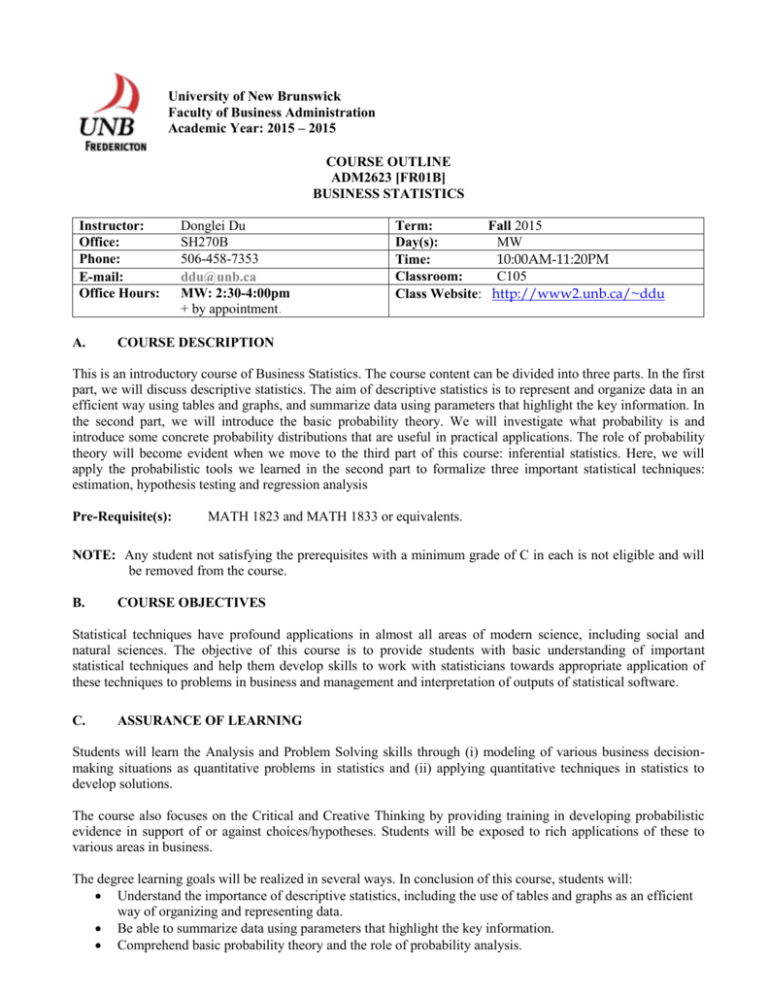
University of New Brunswick Faculty of Business Administration Academic Year: 2015 – 2015 COURSE OUTLINE ADM2623 [FR01B] BUSINESS STATISTICS Instructor: Office: Phone: E-mail: Office Hours: A. Donglei Du SH270B 506-458-7353 ddu@unb.ca MW: 2:30-4:00pm + by appointment. Term: Fall 2015 Day(s): MW Time: 10:00AM-11:20PM Classroom: C105 Class Website: http://www2.unb.ca/~ddu COURSE DESCRIPTION This is an introductory course of Business Statistics. The course content can be divided into three parts. In the first part, we will discuss descriptive statistics. The aim of descriptive statistics is to represent and organize data in an efficient way using tables and graphs, and summarize data using parameters that highlight the key information. In the second part, we will introduce the basic probability theory. We will investigate what probability is and introduce some concrete probability distributions that are useful in practical applications. The role of probability theory will become evident when we move to the third part of this course: inferential statistics. Here, we will apply the probabilistic tools we learned in the second part to formalize three important statistical techniques: estimation, hypothesis testing and regression analysis Pre-Requisite(s): MATH 1823 and MATH 1833 or equivalents. NOTE: Any student not satisfying the prerequisites with a minimum grade of C in each is not eligible and will be removed from the course. B. COURSE OBJECTIVES Statistical techniques have profound applications in almost all areas of modern science, including social and natural sciences. The objective of this course is to provide students with basic understanding of important statistical techniques and help them develop skills to work with statisticians towards appropriate application of these techniques to problems in business and management and interpretation of outputs of statistical software. C. ASSURANCE OF LEARNING Students will learn the Analysis and Problem Solving skills through (i) modeling of various business decisionmaking situations as quantitative problems in statistics and (ii) applying quantitative techniques in statistics to develop solutions. The course also focuses on the Critical and Creative Thinking by providing training in developing probabilistic evidence in support of or against choices/hypotheses. Students will be exposed to rich applications of these to various areas in business. The degree learning goals will be realized in several ways. In conclusion of this course, students will: Understand the importance of descriptive statistics, including the use of tables and graphs as an efficient way of organizing and representing data. Be able to summarize data using parameters that highlight the key information. Comprehend basic probability theory and the role of probability analysis. D. Be able to apply probability analysis to concrete situations. Be able to apply inferential statistical techniques of estimation and hypotheses testing to real world problems. COURSE MATERIALS Text Book (optional): 1. Statistical Techniques in Business and Economics - First Canadian Edition, by D. Lind, W. Marchal, R. Mason, S. Gupta, S. Kabadi, and J. Singh, McGraw-Hill Ryerson, Toronto, 2004. Or 2. Open source textbook: OpenIntro Statistics, 2nd Edition, D. M. Diez, C. D. Barr, and M. Cetinkaya-Rundel (http://www.openintro.org/stat/textbook.php) E. EVALUATION COMPONENTS AND WEIGHTS i. Components ii. List of Components Final Exam (comprehensive) Quiz 1 Quiz 2 Quiz 3 Midterm Quiz 4 Quiz 5 TOTAL OF ALL COMPONENTS Grade Determination Final grade [90, 100] [85, 90) [80, 85) [75, 80) [70, 75) [65, 70) [60, 65) [55, 60) [50, 55) [0, 50) F. Group OR Individual Individual Individual Individual Individual Individual Individual Individual Percent of Total Grade 35 7 7 7 30 7 7 100 % Test Time TBA by University Sept. 23, 2015(W) Oct. 7, 2015(W) Oct 21, 2015 (W) Nov 4, 2015(W) Nov 18, 2015 (W) Dec. 2, 2015(W) Letter grade A+ A AB+ B BC+ C D F COURSE UNDERSTANDINGS 1. There will be assignments, but the assignments will not be graded. However, the questions in quizzes/exams will be similar to the assignments. Therefore finishing these assignments independently will not only be very helpful in preparing for all examinations, but also enhance your understanding of the materials. [COURSE AND [SECTION No]] COURSE OUTLINE PAGE 3 OF 6 2. Each quiz will be of twenty (20) minutes duration starting from the beginning of each designated class. The final exam will be of three hours (180 minutes) duration (Please refer to the schedule above in E). 3. All exams and quizzes are closed books and notes. A formula sheet, exactly the same as the one at the end of this course outline, will be provided by the instructor for all examinations. No self-prepared formula sheet is allowed. 4. Students who miss quizzes for whatever reasons will have the weights of the missed quizzes carried on to the final Exam. 5. Questions and problems in all exams will be based on material discussed in the class. It is your responsibility to attend class regularly to get all the information related to the course throughout this term. Please note that attendance is expected and a student is unlikely to complete the course with success if absent. Candidates will turn off cell phones, pagers, blackberries, or other electronic devices for the duration of a class. 6. Students are required to present a picture ID in order to write exams. 7. There will be a final examination in this course. Please do not book flights in advance of ascertaining the examination dates (location and examination date will be announced by the University). Request for permission to write early final exam will not be granted. Request for permission to write deferred final exam must go through the Registrar's Office. G. ACADEMIC INTEGRITY The University of New Brunswick places a high value on academic integrity and has a policy on plagiarism, cheating and other academic offences. Plagiarism includes: 1) quoting verbatim or almost verbatim from any source, including all electronic sources, without acknowledgement; 2) adopting someone else’s line of thought, argument, arrangement, or supporting evidence without acknowledgement; 3) submitting someone else’s work, in whatever form, without acknowledgement; and 4) knowingly representing as one’s own work any idea of another. Examples of other academic offences include: 1) cheating on exams, tests, assignments or reports; 2) impersonating somebody at a test or exam; 3) obtaining an exam, test or other course materials through theft, collusion, purchase or other improper manner; 4) submitting course work that is identical or substantially similar to work that has been submitted for another course; and 5) more, as set out in the academic regulations found in the Undergraduate Calendar (https://eservices.unb.ca/calendar/undergraduate/). Penalties for plagiarism and other academic offences range from a minimum of F (zero) in the assignment, exam or test to a maximum of suspension or expulsion from the University, plus a notation of the academic offence on the student’s transcript. For more information, please see the Undergraduate Calendar, Section B, Regulation VIII.A (https://eservices.unb.ca/calendar/undergraduate/display.cgi?tables=regulationsSubLevel1&id=43) or visit: http://nocheating.unb.ca. It is the student's responsibility to know the Regulations. FORMULA SHEET [COURSE AND [SECTION No]] COURSE OUTLINE PAGE 4 OF 6 [COURSE AND [SECTION No]] COURSE OUTLINE 22. E[ X ] xi P ( xi ) i 1 23. V [ X ] x P( xi ) xi P( xi ) i 1 i 1 2 2 i Sample binominal table (test tables will be similar but may have different n) PAGE 5 OF 6 [COURSE AND [SECTION No]] COURSE OUTLINE PAGE 6 OF 6

